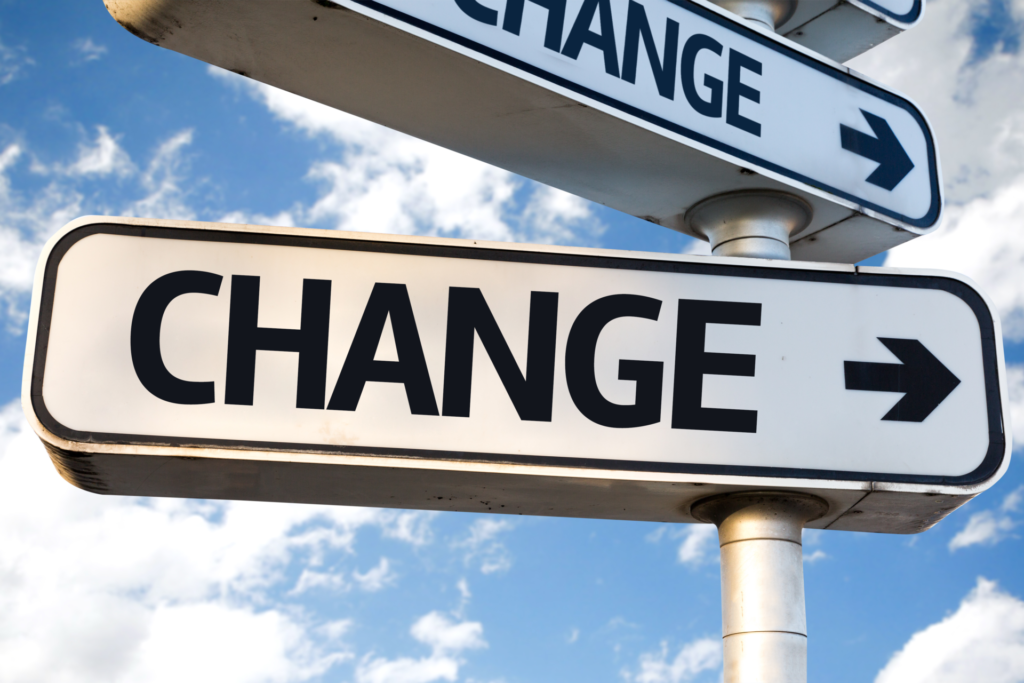
“The Only Constant in Life Is Change.”- Heraclitus
One of our coaching students recently asked this question: what should we say to our clients about how long change takes? What can they realistically expect?
This relevant question has many layers, of course, and various factors that might influence how a client (or we) might change, and the pace of change. What can we offer our clients on this topic, knowing that there are so many different elements to change?
What Influences the Possibilities for Change?
Many of the influencing factors around human development and change come to mind here. For example, the client’s nature/nurture configuration and overall constitution, previous lived experience including personal or cultural oppression or systemic issues like racism, family, societal, economic, political, religious, timeframe/era at birth (e.g. war or other conflict), sibling order, parental mental or physical health and stability, trauma, access to sufficient resources, generational strife, significant illness or loss (self or caregivers), particular habit patterning/strategies. The possible impacting elements around change are robust and complex, and this is not a complete list!

From a coaching lens, here are some additional facets that may influence the change process that we can consider when clients come into coaching:
- How motivated is the client
- Skill, resources and tools of the coach
- The experience of the coach in doing her own work, so that she can reasonably know and support the change territory from her own experience
- How willing, ready or capable is the client to experiment with new things
- How open the client is to practice something different from what can feel like significant behavioral patterns that have been used over many, many years and have reliably worked for the client so far (until now…)
- What objective inner or outer obstacles are the client working with
- What inherent strengths and outer support does the client have or need
- What is the client’s level of tolerance for discomfort and ability to resource themselves
- What level of trust and safety within the coaching container can you both build?
Stepping Through Change – Mind, Body and Heart

What I’ve noticed for myself and my clients is this: it takes many, many incremental movements over time to create real change. I’m not referring to window-dressing change, or as my father used to say, “rearranging the deck chairs on the Titanic.” I’m talking about physiologically supported, embodied and sustainable change. Most interesting for me is the Body, and what role “below the neck” plays in what I’m calling the real or developmental change that is evidenced by outer behavioral change. I’m including the Heart here as well, since it is located in the lower two-thirds of our human anatomy and is distinct from our strictly cognitive functioning (the Mind).
In my own growth work, and in working with clients, I observe the Mind can usually change very quickly. We can feel inspired, take on new ideas quite rapidly. We can talk about exciting ideas or visions for the future. As my husband says: “it briefs well.” And, when we get into change that is the actual development of an adult human, that enables someone to show up differently, to actually BE different, so they can DO differently, well, that’s where the rubber hits the road. We know as coaches, it’s often not that easy for our clients to put a good idea into practice. There are other parts of us humans that need to come on board in order to practice and demonstrate a sustainable change in behavior.
That’s where the pacing difference of various parts of us as humans related to the in change process becomes relevant. The Heart and Body seem to need more time to catch up to what the Mind may be able to grasp quickly. Creating actual new and different actions must include these other parts of us, these inner systems or centers.
Exploring Pacing through Presence
I perceive at least two reasons for the phenomenon of this distinct pacing. First, the Body and Heart can hold our history in a different way than the Mind does. Our lived experience is actually embodied over time and lives within the tissues and bones of our physical and biological organism. The second reason stems from the first: there are many unchecked notions, beliefs and assumptions about who we are and what life is that have been learned way back when. What’s driving behaviors that may no longer serve the client’s coaching goals can lie out of awareness, and yet still run the show.
Our clients can’t often put a finger on exactly what is motivating certain behaviors, yet when they enter into a coaching process, what is out of awareness, through Presence, can be revealed. Having a “safe” psychological space in a coaching conversation to take a dive under the waterline of conscious awareness can reveal simple yet profound whole-self insights and understanding around these motivators. As we work with our client’s holistically, including the Body, Heart and Mind in the present moment, we as coaches can support our client to make new meaning about these drivers that more fit current reality and align with their commitments and coaching goals. The client can then experiment by embodying and practicing new behaviors, which can lead to achieving results more in line with who the client wants to be, and where the client wants to go.
I’ve noticed that the Heart and Body are generally slower in this process than we are used to watching in the mind (although the mind can reliably throw up its own obstacles to change–think about those unwelcome inner-critic voices!). Our executive control of attention can shift on a dime and is highly distractable. You can notice how quickly we can get pulled into reading the news or scrolling a social media app.
It appears that the Heart and Body need more time to digest what’s happening and actually, seem to be on their own time frame around change.
Including our Body and Heart in Change

Paying attention to this slower pace in the Body and Heart can yield interesting outcomes. A useful metaphor is how we metabolize new information inside of us like we do food. Over time, we process what we have ingested, take needed nutrients from that experience, and discard what’s not (or no longer) needed. Like our own internal food digestion process, this happens over time. We can get indigestion from stuffing too much in the system at one time, or by simply not eating the foods our body needs.
Giving attention to our Body and Heart view of whatever change we are undertaking can be very useful in guiding us to what’s needed around pace. Tuning into our Heart and its innate intelligence can produce salient information in terms of where we actually are in our own process of digestion. For example, in the Heart we may be letting go of old ways of being and behaving, shifting our sense of identity in the world or in our relationships, or getting in touch with what’s truly important to us, and noticing what’s calling us in terms of serving others or expressing our unique gifts.
The body itself feels safe and comfortable in our usual routines. Our nervous system is easily triggered and thrown off by external circumstances that seem to be demanding we change to meet them (think pandemic). Even experimenting with slightly changing the cadence of our breath can produce whole-body tension and contraction. It takes time and ongoing practices to embody a new behavior and the body is a needed ally in this process.
A personal example of this pace of change is our recent move to Asheville. I am noticing that just recently after four months in this location, I’m beginning to feel like I’m not on vacation here, but actually live here! I have had the plan (Mind) to relocate to Asheville for many years. Actually, moving here (Body) was a pretty rough transition, even though the clear desire to move here was present (Heart). Moving is a big personal disruption, added to the many additional disruptions we have all been facing in the last year!
It’s taken these last few months, and likely will take more time, to digest this move in my Heart and Body. And my feeling more like “home” in these mountains has been the result of taking new actions (Body). I notice that I have slowly and surely been putting various roots down, like meeting neighbors, finding medical practitioners and services like haircuts, unpacking and settling inside our home, finding a grocery store, post office, creating suitable workspace. Ahh, that feels better (exhale here – I think I’m digesting)!
Questions to Further Explore the Pace of Change

So, change takes the time it takes, and there may be different paces of change within ourselves within our three centers (Mind, Heart and Body) to pay attention to for ourselves and as we work with our clients. Circling back to the question from our student at the beginning, what do we tell our clients about how long change takes? You might be wanting a concrete answer here, and instead of that, I hope I’ve illuminated that this process of human change and development is complex and somewhat of a mystery! I’ll leave you with these questions to ponder:
- What will you say to your clients about change?
- What has been your experience of change, and what enables it and delays it?
- What do you notice about the experiences of your own Mind, Heart and Body in change?
- What do you observe about the different paces of these three centers?
- What will you take away and apply from this article?
Wishing you the best in any personal or professional change efforts you are undertaking, and as you support your clients or organizations to make the changes that are needed right now. In addition, as we are all acutely aware, there are still many changes and challenges underfoot in our world each day to navigate and work with that we didn’t choose, that are calling us to be and act differently in response. Perhaps in all of this, we can take whatever time is needed, have patience with the change process, and hold compassion for this human journey we are all on.
